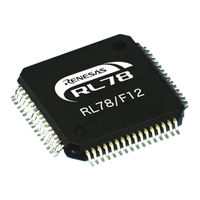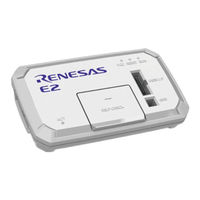Renesas RL78/I1A Manuals
Manuals and User Guides for Renesas RL78/I1A. We have 5 Renesas RL78/I1A manuals available for free PDF download: User Manual
Renesas RL78/I1A User Manual (1176 pages)
16-Bit Single-Chip
Brand: Renesas
|
Category: Microcontrollers
|
Size: 9 MB
Table of Contents
-
-
Memory Space
62 -
-
SFR Addressing104
-
Based Addressing106
-
Stack Addressing111
-
-
-
Port Functions115
-
-
-
-
-
-
-
-
-
-
-
-
-
-
-
-
Master Reception603
-
Slave Reception632
-
-
Communication655
-
-
-
LIN Transmission688
-
LIN Reception691
-
-
-
-
-
UART Reception739
-
DALI Mode
754-
DALI Reception765
-
-
Communication780
-
-
-
-
-
Start Conditions808
-
Addresses809
-
Stop Condition811
-
Wait812
-
Canceling Wait814
-
Error Detection816
-
Extension Code816
-
Arbitration817
-
Wakeup Function819
-
Cautions826
-
-
Timing Charts
855
-
-
-
-
-
Standby Function936
-
-
HALT Mode937
-
STOP Mode944
-
SNOOZE Mode949
-
-
-
-
-
Chapter 26 Regulator
1004-
Regulator Overview
1004
-
-
-
-
Communication Mode1017
-
-
P40/TOOL0 Pin1019
-
RESET Pin1019
-
Port Pins1020
-
REGC Pin1020
-
X1 and X2 Pins1020
-
Power Supply1020
-
-
Self-Programming
1026 -
Security Settings
1031 -
Data Flash
1033
-
Advertisement
Renesas RL78/I1A User Manual (59 pages)
Emulator
Brand: Renesas
|
Category: Computer Hardware
|
Size: 1 MB
Table of Contents
-
Overview7
-
RESET# Pin25
-
TOOL0 Pin28
-
Gnd29
-
VDD29
-
Reset46
-
Flash Memory46
-
Gdidis47
-
Go to Here]49
Renesas RL78/I1A User Manual (58 pages)
E1/E20/E2 Emulator, E2 Emulator Lite
Brand: Renesas
|
Category: Computer Hardware
|
Size: 0 MB
Table of Contents
-
Overview7
-
RESET# Pin25
-
TOOL0 Pin28
-
Gnd29
-
VDD29
-
Reset46
-
Flash Memory46
-
Gdidis47
-
Go to Here]49
Advertisement
Renesas RL78/I1A User Manual (55 pages)
Brand: Renesas
|
Category: Computer Hardware
|
Size: 0 MB
Table of Contents
-
-
-
-
-
RESET# Pin25
-
TOOL0 Pin28
-
Gnd29
-
VDD29
-
-
-
Reset45
-
Flash Memory45
-
Gdidis46
-
-
Go to Here]48
Renesas RL78/I1A User Manual (53 pages)
16-bit Microcontroller
Brand: Renesas
|
Category: Microcontrollers
|
Size: 2 MB




